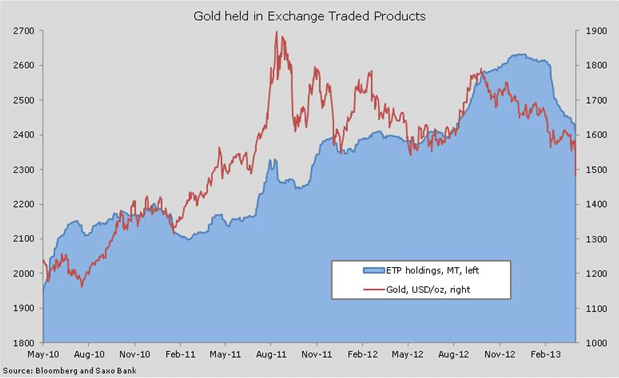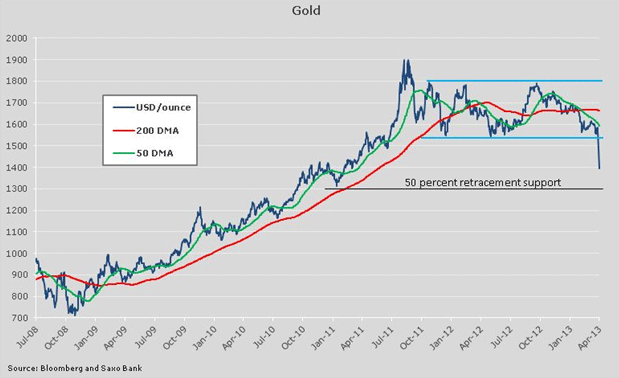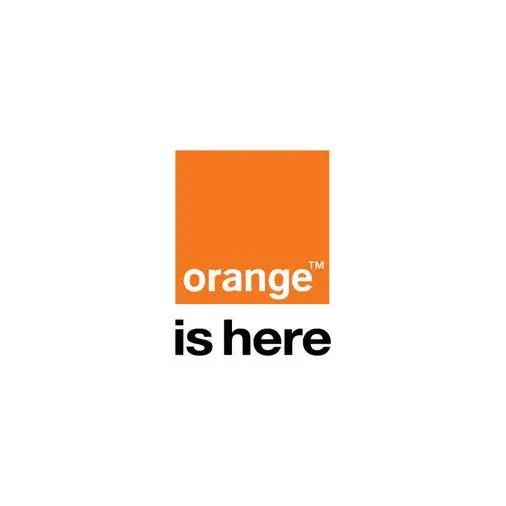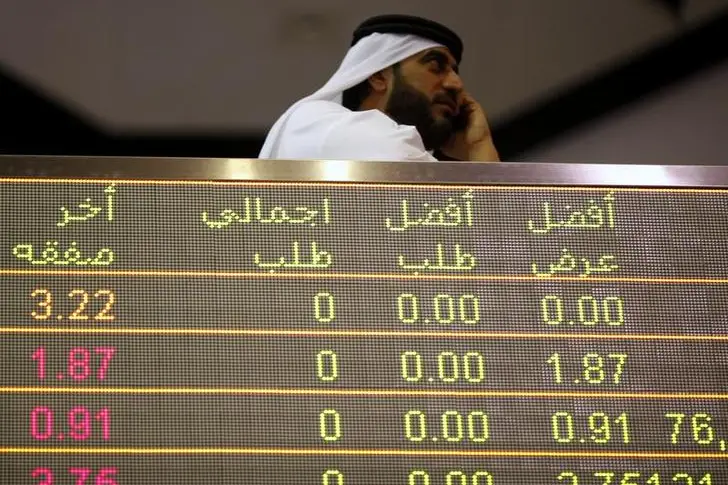The near free fall in gold over the past few trading days has pushed other financial news off the front pages. Gold, which has been the darling of many investors over the past decade and has offered rich rewards during that time, is suddenly looking vulnerable. Will this latest move spell the end of the rally that began back in 2001 or will history show this as being a great opportunity to invest?
Up until last Friday, gold had spent the past 18 months consolidating in a wide range between 1,525 USD/oz and 1,800 USD/oz. But particularly since last September, we have witnessed a slow drift lower following a third rejection of the 1,800 USD/oz level. Speculative traders such as hedge funds, which tend to be quick on the trigger when changes are looming, began losing faith back in September: from a peak net-long futures and options position of almost 20 million ounces, they started a gradual reduction that, by last Tuesday, had seen their position dwindle to just 5.6 million ounces. 
Investors who used Exchange Traded Products (ETPs) or Exchange Traded Funds (ETFs) to gain long exposure to gold continued to accumulate or maintain their position well into February, by which time the ongoing price weakness began to have an impact. This investor segment is generally viewed as longer-term. Apart from many small retail investors, it also includes some big hedge funds such as Paulson & Co, which by the end of 2012 held 21.8 million shares in the biggest fund, the SPDR Gold Trust. The trigger in February that led to a pick-up in ETP holdings being reduced was the technical break below 1,625 USD/oz, which a few days later was followed by the technical sell signal called the death cross on February 20. Such a signal, which is triggered when the 50-day moving average crosses the 200-day, has on two out of three occurrences during the past five years triggered 15 percent and 8 percent sell-offs.
With so much invested in exchange-traded products, the ball began rolling. During the past month, we have witnessed continued long liquidation despite fundamental support coming from the European debt crisis represented by Cyprus, softer economic data from the US and China, and a massive asset-purchase programme from the Bank of Japan.
What really rattled investors' nerves last week was the potential for Cyprus to sell its gold reserves to cover losses. Such a sale could easily be absorbed by the market. But the worry spread that this, if implemented, could become precedent for other peripheral Euro area members' central banks. Such action would have a much greater impact on gold markets considering the current holdings of countries like Spain and Italy. Adding to this continued price downgrade from another of the major bullion houses, the course was set and once the 1,525 USD/oz support level was reached and breached, as if it did not exist, waves of selling orders from both the spot and futures market sent the price into a tailspin. During the initial hour of carnage last Friday, almost 9 million ounces of gold futures had swapped owners.
Technical perspective
The USD 59 loss on Friday was followed by an even greater move today and the big question everybody is now asking is when will the selling stop? As mentioned earlier, fundamental support has risen but has been ignored in recent weeks. Until a floor can be established, additional economic weakness that could point towards a continuation of support from asset purchases in the US will have limited if no impact. The Technical picture obviously looks very bleak, with strong resistance now established between 1,500 USD/oz and 1,525 USD/oz, an area that undoubtedly will be met by new selling should that be revisited soon.
The downside looks pretty open down towards 1,300 USD/oz, which represents a 50 percent retracement of the rally following the Lehman Bros collapse in the autumn of 2008. Also it is worth noting that the current price just above 1,400 USD/oz is within the consolidation area between 1,300 USD/oz and 1,425 USD/oz, where gold spent six months from late 2010 to early 2011.
Once the dust settles
The multi-year rally is over, but it is probably too early to make a call for a complete trend reversal. The coming days and weeks will be very important as this has now become of war of nerves. Will ETP investors, especially the larger ones, be forced to continue selling? Along with hedge funds going net-short, this scenario could create further weakness. Or will the current slowing economic climate eventually trigger some support? As mentioned in previous outlooks, we maintained a constructive view on gold, but were also aware that a break below 1,500 USD/oz would be a potential game changer. We look for support towards 1,300 USD/oz followed by a long period of consolidation, with the USD 1,550 per ounce area offering resistance.
The process of rebuilding investors trust will be a long one and one that has not yet begun.
NON-INDEPENDENT INVESTMENT RESEARCH
This investment research has not been prepared in accordance with legal requirements designed to promote the independence of investment research. Further it is not subject to any prohibition on dealing ahead of the dissemination of investment research. Saxo Bank, its affiliates or staff, may perform services for, solicit business from, hold long or short positions in, or otherwise be interested in the investments (including derivatives), of any issuer mentioned herein.
None of the information contained herein constitutes an offer (or solicitation of an offer) to buy or sell any currency, product or financial instrument, to make any investment, or to participate in any particular trading strategy. This material is produced for marketing and/or informational purposes only and Saxo Bank A/S and its owners, subsidiaries and affiliates whether acting directly or through branch offices ("Saxo Bank") make no representation or warranty, and assume no liability, for the accuracy or completeness of the information provided herein. In providing this material Saxo Bank has not taken into account any particular recipient's investment objectives, special investment goals, financial situation, and specific needs and demands and nothing herein is intended as a recommendation for any recipient to invest or divest in a particular manner and Saxo Bank assumes no liability for any recipient sustaining a loss from trading in accordance with a perceived recommendation. All investments entail a risk and may result in both profits and losses. In particular investments in leveraged products, such as but not limited to foreign exchange, derivatives and commodities can be very speculative and profits and losses may fluctuate both violently and rapidly. Speculative trading is not suitable for all investors and all recipients should carefully consider their financial situation and consult financial advisor(s) in order to understand the risks involved and ensure the suitability of their situation prior to making any investment, divestment or entering into any transaction. Any mentioning herein, if any, of any risk may not be, and should not be considered to be, neither a comprehensive disclosure or risks nor a comprehensive description such risks. Any expression of opinion may be personal to the author and may not reflect the opinion of Saxo Bank and all expressions of opinion are subject to change without notice (neither prior nor subsequent).
Futures contracts are traded on margin enabling you to leverage a small margin deposit for a much greater market effect. You will be required to deposit initial margin to initiate a position. You must also maintain the Maintenance Margins listed per contract in your account at all times. If the funds in an account fall below this margin, clients will be subject to a margin call to either deposit more funds to cover positions or close positions. You will usually be notified of this through our trading platform and via e-mail. If you fail to do so as required, your position may be closed or liquidated.
Saxo Bank does not support physical delivery of the underlying security on expiry of a futures contract. You should ensure that you are aware of the expiry and first notice dates (FND) of any futures contracts and that you close these at the appropriate time. If the FND is before the expiry date, positions need to be closed the day before the FND. If the expiry date is before the FND positions need to be closed no later than on the expiry date. If futures positions are not closed before the relevant date, Saxo Bank will close the position on your behalf at the first available opportunity at the prevailing market rate. You will bear any resulting costs, gains or losses. Our Futures do not provide any right to the underlying instruments.
In certain cases, our, Futures are over-the-counter (OTC) instrument. Each Future trade that you enter into on our trading service results in you entering a contract with us; these contracts can only be closed with us and are not transferable to any other person.
This means that you may be exposed to the risk of our default. In this unlikely event, we are members of the Danish Financial Services Compensation Scheme.
The following risks relevant to any investment in this product:
There may be significant fluctuations in the market or index underlying this investment that may give rise to losses;
Investment will involve exposure to foreign currency exchanges rates which may move unfavourably and give rise to losses;
This investment is based on an underlying [instrument / index / market / etc.] that is potentially unpredictable and volatile.
There may be a sudden shift in the price of an underlying from one level to another and substantial losses may result from such movements in the underlying.
In setting prices and contract terms, we take into consideration the market or the markets for the relevant underlying instruments. Market conditions can change rapidly over a short period of time, so if you want to close out a contract we might not be able to do so on the same terms.
In considering the potential profit associated with any investment you should be aware of the costs and charges applicable to that product that will reduce such profitability.
This communication refers to past performance. Past performance is not a reliable indicator of future performance. Indications of past performance displayed on this communication will not necessarily be repeated in the future. No representation is being made that any investment will or is likely to achieve profits or losses similar to those achieved in the past or that significant losses will be avoided.
Statements contained on this communication that are not historical facts and which may be simulated past performance or future performance data are based on current expectations, estimates, projections, opinions and beliefs of the Saxo Bank Group. Such statements involve known and unknown risks, uncertainties and other factors, and undue reliance should not be placed thereon. Additionally, this communication may contain 'forward-looking statements'. Actual events or results or actual performance may differ materially from those reflected or contemplated in such forward-looking statements.
This material is confidential and should not be copied, distributed, published or reproduced in whole or in part or disclosed by recipients to any other person.
Any information or opinions in this material are not intended for distribution to, or use by, any person in any jurisdiction or country where such distribution or use would be unlawful. The information in this document is not directed at or intended for "US Persons" within the meaning of the United States Securities Act of 1993, as amended and the United States Securities Exchange Act of 1934, as amended.
This disclaimer is subject to Saxo Bank's Full Disclaimer available at www.saxobank.com/disclaimer.
© Press Release 2013



















